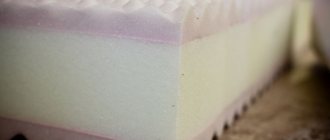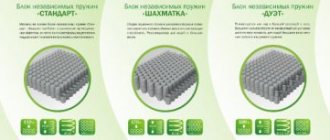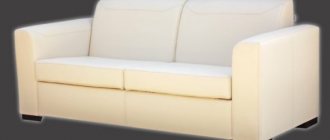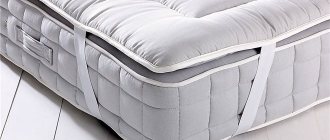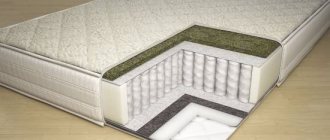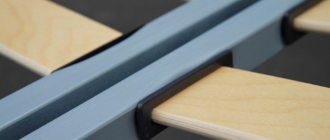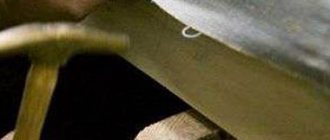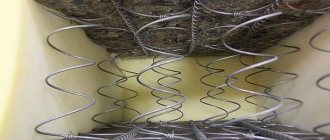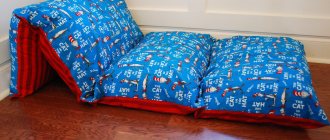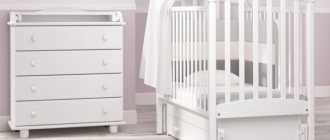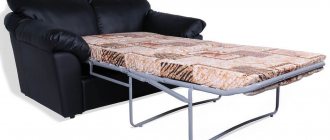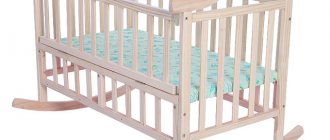Polyurethane foam brands
When considering the options for which foam rubber to choose for furniture, first of all pay attention to the brand of the proposed material: it determines the main indicators, and the numbers that follow clarify the information (density and hardness):
There are several more varieties (RTS, RL, VE, secondary foam rubber), and the list is constantly expanding.
How to choose foam for a sofa
If you need to replace the filling in a sofa, consider a few nuances:
High-quality material is not too cheap - so stick to average prices and choose reliable manufacturers.
Which foam rubber to choose for the sofa will depend on the type of furniture:
For other types of furniture, the recommendations are approximately the same: a budget option is ST brand foam rubber; when restoring, take material with enhanced characteristics.
Which foam rubber to choose for a mattress
There are 2 main brands used in the manufacture of mattresses:
For a guest bedroom or a thin person, buy 10 cm thick polyurethane foam, if the weight is above 60 kg, increase the value by 1.5 times or higher.
The question of how to choose foam rubber for a mattress will leave you with no ambiguities - after all, you already know what the marking says and can buy what you need. Sheet foam rubber remains the most popular material in the production of furniture - and at the same time quite inexpensive.
Source
Features of the filler and its difference from polyurethane foam
Foam rubber is produced by mixing two hydrocarbon bases, which, after being combined, begin to actively foam. To prevent the material from falling off, additives are added to it. The type of stabilizers is significantly different from those added to polyurethane foam. The result is an airy cellular material that is characterized by increased elasticity and viscosity. At the same time, adding lower-quality additives still cannot provide the same quality of filler as in the case of polyurethane foam.
As a result, foam rubber can quickly begin to crumble and collect unpleasant odors. To preserve the filling, the mattress must be covered with a voluminous cover. The exception is completely budget models. They can be sold without a cover, simply in the form of a twisted roll, or sheathed with ordinary thin cotton fabric and synthetic fiber.
Ivan Bokorezov
Furniture columnist and designer
Ask a Question
Mattresses with foam rubber require careful care. Despite good air circulation, this property becomes not only an advantage, but also a disadvantage. If liquid gets inside the fibers or tobacco smoke gets on them, all these odors remain inside. It is very difficult to weather them, which requires the use of quite aggressive substances.
Foam rubber for a mattress - how not to be deceived
Foam mattress is a slightly confusing name. However, it should be noted that scientific and technological progress affected not only telephones, cars and computers, but also all other industries. The Soviet foam rubber known to us “from old memory” has long become a modern, high-tech filler. It's time to destroy stereotypes, debunk myths and tell the truth about foam rubber for mattresses. By the way, the more correct name for the foam material under discussion is polyurethane foam (foam rubber is more of a common noun).
Myths and truth about foam rubber
First, we will debunk several myths about foam rubber, and then move on to discussing the topic of what foam rubber is needed for a mattress. Let us clarify once again that foam rubber and polyurethane foam are the same thing (different names for the same material). And if the seller claims that there is some difference between foam rubber and polyurethane foam in mattresses, this fact only indicates the ignorance of this consultant.
Myth 1. Foam mattress is too soft
For many, this stereotype was formed in Soviet times or as a result of the obvious (bath and kitchen sponges, packaging foam rubber are actually made from soft grades of polyurethane foam). However, many consumers do not even realize how diverse modern polyurethane foams are (there are more than 130 brands). The development of new compositions and improvement of old foam formulations is ongoing.
Reference! In addition to standard brands, there are reinforced (increased rigidity), extra-hard, highly elastic and viscoelastic brands of foam rubber for mattresses.
Myth 2. Foam mattresses are not recommended for people with spinal diseases
This stereotype is destroyed under the onslaught of facts. Mattresses made from certain brands of polyurethane foam have medical certificates and are used as orthopedic products.
New generation foam rubber - memory polyurethane foam - is a special category. In many cases, they are simply irreplaceable - as an anatomical top covering or a full-fledged filler in mattresses and pillows for people with vascular problems, diseases of the joints, bones and spine, as well as for the elderly.
Myth 3. Foam mattresses are short-lived
The lifespan of a foam mattress directly depends on what type of foam you choose for the mattress (meaning the brand). The higher the density of the foam filler, the longer the mattress will last without losing quality characteristics. The service life of mattresses made from high-quality polyurethane foam is up to 10 years (as well as blocks of independent springs).
Myth 4. Foam mattress is synthetic and causes allergies
A foam mattress purchased from a reliable manufacturer does not emit an odor (only a characteristic odor that quickly dissipates when unpacked), does not emit harmful substances, and is hypoallergenic. The CertiPUR (European standard certification) mark on the packaging confirms that even the foam production process did not harm the environment, being strictly controlled at all stages.
No matter what materials and technologies the mattress masters invent, fillings made from good old foam rubber are constantly and confidently gaining popularity. Let's figure out why this happens.
What is foam rubber
The first samples of foam rubber appeared thanks to experiments in Germany (1941). German scientists developed solid, monolithic polyurethane, and as a by-product they obtained elastic foam rubber.
By the way, the name “foam rubber” itself has an interesting history. In the Soviet Union, in the manufacture of upholstered furniture, polyurethane foam (PPU) from the Norwegian company Porolon was used as a filler. People got used to this name and since then the name “foam rubber” has been firmly established in the country for polyurethane foam.
After the collapse of the USSR, many enterprises began to produce their own foam rubber. But it was of such low quality that it simply could not withstand heavy loads. Furniture made on the basis of filler quickly deteriorated, and therefore the popular opinion spread that foam rubber is worse than polyurethane foam. But serious enterprises were able to defend their right to be on the market by learning to produce high-quality foam rubber. And today there are so many brands of polyurethane foam on the market that it is difficult for an ordinary buyer to decide which foam rubber to choose for a mattress.
So, foam rubber is an elastic, fine-celled polyurethane foam, consisting of 90% air. It is obtained when special components foam and harden. Depending on what kind of foam rubber you need to obtain, the composition of the raw materials depends. The hardening process lasts up to three days. Foam rubber can be block or sheet.
Advantages of foam filling
- Mattresses with PU foam filling do not have a “wave effect” - people sleeping on the same bed do not interfere with each other.
- Foam mattresses are particularly elastic and soft - after compression, the shape of the product is immediately restored.
- Foam rubber is an absolutely hypoallergenic material. It is ideal for both children and adults.
- The cellular structure provides the foam with high breathability and the ability to retain heat.
- Durability: good quality material has a service life of 10–15 years without loss of properties.
- Hygiene: foam rubber does not rot, mold and pathogenic microbes do not form in it.
- Foam mattresses are easy to care for. They are easy to transport.
Foam hardness
Today, foam rubber for mattresses is a lightweight, relatively inexpensive and fairly wear-resistant material. Modern foam mattresses have excellent orthopedic properties and support the correct position of the spine during sleep. The service life of a good PPU mattress is approximately 10 years. But a low-quality foam mattress will last only 2-3 years.
To choose a good foam mattress, pay attention to the hardness of the filler. Stiffness refers to the amount of force required to compress the foam by 40%. Measured in kPa. Foam rubber is divided into several types according to hardness:
- standard ST – foam with excellent recovery properties at good densities,
- soft HS - low-density material used in armrests and headrests of upholstered furniture,
- hard HL - this type of foam is used under conditions of increased loads and where maximum durability is required,
- increased rigidity EL – increased rigidity foam, reinforced polyurethane foam. It appeared not so long ago, but has already taken a dominant position in the market, thanks to its quality characteristics,
- increased comfort HR or HR* – highly elastic foam, similar to latex. Very popular among consumers due to its comfortable firmness and elasticity.
There are brands of polyurethane foam with additional properties:
- fire resistant FR
- viscoelastic VE
- with shape memory LR
The marks VE and LR mean that the material has a memory or “memory effect”. This is the most expensive type of foam rubber. Work in the development of new types of foam rubber does not stop, so new and improved varieties of polyurethane foam are constantly appearing on the market. To distinguish between types of foam rubber, the manufacturer can add dyes to the materials.
Foam density
Density is an important indicator when choosing foam rubber. It determines how durable the mattress will be. The more load the product is subjected to, the denser the foam should be.
Based on density, foam rubber can be divided into several groups:
- 16-25 kg/m3 – low-density.
- 28-35 kg/m3 – medium-density.
- 40-60 kg/m3 – heavy.
Foam thickness
On the foam mattress market you can find models with thicknesses of 5 cm, 7 cm, 10 cm, 12 cm, 15–30 cm. Every centimeter matters. Mattresses with a thickness of less than 10–14 cm, as a rule, do not have orthopedic properties and are not able to provide support for the spine of a sleeping person. This is an option for a sleeping place in the country.
It is pleasant to lie on a soft foam mattress; it resembles a soft feather bed. But orthopedists do not recommend sleeping on it regularly. The maximum load for such a mattress is up to 90 kg.
Medium-hard foam rubber can hold and restore its shape, but it’s a stretch to call mattresses with such a filler orthopedic. Withstands loads up to 110 kg.
Hard PU foam mattresses provide excellent support for the spine. They can already be called orthopedic products. The necessary rigidity in this type of mattress is achieved not only by the properties of foam rubber, but by supplementing the foam rubber with other materials, for example, coconut coir. Can withstand a maximum load of up to 140 kg.
How to understand foam rubber for mattresses
The range of polyurethane foams is large, so the question of how to choose foam rubber for a mattress is relevant.
Main parameters of PPU (foam rubber)
For the average consumer, the most important are the three characteristics reflected in the labeling.
Reference! These three parameters, along with the characteristics of elasticity, strength, comfort and several other narrow-profile indicators, determine the brands of foam rubber.
Suitable PU foam brands for mattresses
We have come to the main question: what density of furniture foam is needed for a mattress. We will not discuss all commercially available brands of foam rubber, but only those that deserve attention as worthy and relatively durable.
PPU brands are designated by a set of letters (Latin) and numbers. The letters indicate the type of material used in production. The first 2 digits are density indicators (kg/m³), the second 2 indicate the degree of hardness (kPa).
ST (standard). Basic brands based on one polyol. Used in the production of economy class mattress models. Even in this case, you should not buy a product with a density marking below 35 (ST 3542).
HL (extra hard). Foam rubber with high load-bearing capacity, very dense and hard. Durable, reliable, able to withstand quite serious loads. For example, the HL 4065 brand is used to create mega-springless pants for overweight people.
E L (reinforced). Reinforced by the introduction of a hardness polyol for ST grades (standard). This recipe allows you to achieve a higher degree of rigidity at the same densities as ST. Great brands for mattress blocks start at density 32 (EL 3245).
HS (soft). By and large, neither brand is recommended for mattresses, except as a softening top layer laid on top of a more reliable brand of foam rubber at the base.
HR (high elastic). The four-polyol formulation creates a product with a combination of low stiffness and high load-bearing capacity, which adds comfort. For example, the declared service life of the HR 5535 brand is 15 years, and the HR* 6030 LL (WATERLATTEX) brand is so comfortable that it feels practically no different from natural latex.
LR and VE (viscoelastic). Materials with the so-called memory effect. Depending on the recipes and production technologies, they may have different names (MEMORI, Puralattex, Eliocel, Natural Form and others).
For those who decide to make a mattress from PU foam with their own hands or order a product from a private workshop, the question of selecting a brand of foam rubber is more transparent (since the buyer or customer has the opportunity to see with their own eyes the color of the PU foam and markings). When purchasing a finished product, the question of what brand of foam rubber was used to create the indoor unit often remains open. The characteristic “medium-hard mattress” quite often hides standard brands of foam rubber. It wouldn't hurt to find out which one was used.
Source
The best models of foam mattresses
Despite the availability of such products, there are a number of proven mattress models that, having a combined structure, can last for more than one year and provide proper sleep comfort and back support.
| Name | Type | Peculiarity | Flaw |
| Heggy Baby | Foam rubber + bonnel block | Hypoallergenic Affordable price Long service life Has orthopedic properties | Not suitable for newborns One of the layers is spunbond The springs are not insulated by anything except a thin layer of foam rubber and spunbond |
| Dreamline Roll Massage | Foam rubber + elastic layer, springless | Withstands heavy loads Quickly restores shape Has a textured surface Excellent breathability | Not the longest service life Difficult to care for Quickly absorbs all odors |
| Blue Sleep Gravity | Springless | Double sided Has a massage effect Relieves tension from the musculoskeletal system | Difficult to clean Quickly absorbs all odors |
| Corretto Ruletto 5 | Springless, simply covered with fabric | Affordable Breathable Quite viscous and elastic | The simplest foam mattress, which has all the disadvantages of similar products |
| Ormatek Ranch | TFK block | Excellent orthopedic properties Among the layers there is latex coir Independent springs are protected by spandbond | High cost Among the layers there is spunbond |
If a foam mattress has an unusually low price, it was likely produced using cheap ingredients. Such products do not have a quality certificate and usually their frame is simply covered with woven or regular fabric.
Ivan Bokorezov
Furniture columnist and designer
Ask a Question
A foam mattress is more suitable for temporary sleep or as a preventive measure for bedsores in bedridden patients. If you need to purchase budget models, it is recommended to purchase combined products that, in addition to foam rubber, will also contain other higher quality fillers.
Density
The density of foam rubber is absolutely the same physical characteristic as for any other material. Measured in kg
per
cubic meter
. This means that if we cut a cube with sides 1m x 1m x 1m (1 cubic meter) from a specific brand of foam and weigh it, we will get the desired density value. For example, 25 kg/m3
The DENSITY parameter determines the durability of the foam in the product; the denser the foam, the more durable the furniture will be. Or otherwise, the more loaded the work of an element of upholstered furniture is, the denser the foam rubber should be used.
The examples given help to understand how the operating conditions of an element of upholstered furniture influence the choice of foam brand, so far only in terms of density.
It should also be noted that the density value is directly related to the price of the product. Increasing the density by 2 times leads to a DOUBLE increase in price.
Wide functionality
A foam mattress has the following properties, which are not inferior in characteristics to many other materials:
- steam does not penetrate into the product;
- can be purchased at an affordable price;
- does not become deformed after sleep;
- easy to transport;
- does not conduct heat.
Simple and reliable care
Rules of use:
- The mattress needs to be vacuumed regularly.
- Washing textile bleaches will help deal with stains.
- You can't iron it.
- Only springless mattresses can be folded.
- You cannot jump on mattresses.
- Use mattress pads or covers. This will not only maintain the attractive appearance of your mattress, but will also extend its service life.
High quality products will last about 7 years, provided that they are properly cared for.
Rigidity
Foam rubber can be (in terms of hardness):
Soft and super soft
brands of foam rubber are used in parts of upholstered furniture, which are subject to less pressure, but significant deformation is required. For example, in back cushions.
Standard
(by hardness) foam grades are used in standard parts (chair seats, mattress covers, seat cushions)
Hard and high rigidity
foam brands are used in office furniture (without excessive comfort) and for shaping upholstered furniture elements (rectangular armrests)
The density and rigidity of foam rubber are not uniquely related. Thus, different brands of foam rubber of the same density, depending on the chemical composition and a number of structural features, can have different rigidity, such as brands ST 2536 and S 2520 and EL 2540.
Foam rubber can be low-density
(light, cheap) and
hard
, for example EL 2040 foam, but it will
not
, or it can be
Dense
(heavy and expensive) and
soft
, for example S 3025 foam or S 2520 foam and it will last much longer.
The range of produced foam brands, their characteristics and manufacturer’s recommendations for their use are given in the table:
Source
What is foam rubber and its types - which one is best to use on a sofa?
For many consumers, the discovery will be the fact that foam rubber and polyurethane foam are the same thing! The correct name of the material is soft polyurethane foam (PPU). Several decades ago, the Norwegian company Porolon supplied it to the Soviet Union, so the name became a household name.
Typical filler requirements:
Hence the often skeptical attitude towards foam rubber products: they are short-lived, quickly “sag”, old foam rubber crumbles. Its main disadvantage is considered to be flammability; when burning, toxic gas is released.
The qualitative characteristics of the material changed at the end of the 20th century, when various additives began to be added to the composition, which affected the density, elasticity, flammability, etc. Nowadays, polyurethane foam is used in the manufacture of the vast majority of mattresses.
Production of foam rubber
Polyurethane foam is 90% air; its production process consists of mixing certain components, a chemical reaction between which leads to foaming and hardening of the material.
Chemical production requires attention and strict adherence to technology. Before mixing, the components for the production of polyurethane foam are checked for qualitative and quantitative indicators. In a foaming machine, the components are mixed, the process of foam formation and maturation occurs without the direct participation of the operator.
The polyurethane foam mass is poured into molds; in the case of continuous production, it is placed on a conveyor belt, where the chemical reaction is completed. The time for complete hardening is about 3 days.
The process of cutting foam rubber is carried out on special machines. Cutting form: from simple cubes of different sizes to complex shapes and profiles.
Waste-free foam rubber production is ensured by installations for fine cutting (crushing) of waste.
Damage to foam mattresses
Are there any health risks from polyurethane foam mattresses? Foam mattresses have been made for decades, and the controversy over their harmfulness will not subside. And there are reasons for these disputes: synthetic “origin” and low orthopedic properties. Reviews of polyurethane foam mattresses can be found here.
The material is made from synthetic components. They emit volatile substances with an unpleasant “chemical” odor. And some cheap models, manufactured in violation of technology, retain it for a long time, or even the smell does not disappear at all. The substances released are hazardous to health, just like those released when a mattress burns. But it has not been proven how harmful the released substances are in minimal quantities.
The video shows the density of foam rubber for a mattress:
Harm has not been proven, so polyurethane is the most common material for the production of mattresses.
Its advantages contribute to this:
The harm of foam mattresses also lies in their low orthopedic properties. Doctors insist that the sleeping place should be quite hard. Therefore, mattresses are equipped with an independent block of springs, a layer of coconut coir and other “devices”. And the usual foam version is often soft, bends greatly, which leads to curvature of the spine. The body does not always rest well on soft things; in the morning there may be numbness in the limbs, muscle stiffness, and tingling in them. The result, at a minimum, is poor health and a bad mood. And the maximum is problems with the spine.
How to choose an orthopedic neck pillow?
How to care for the surface and filler
There are no difficulties in caring for products made from foam rubber. The general recommendations that the manufacturer gives for other types of mattresses are suitable for them.
- to vacuum the surface several times a month to prevent rapid abrasion of the surface and the penetration of unpleasant odors from crumbs inside.
- Every month, turn the base over to the other side , and the position of the face and legs must change. This point is especially important for couples with a large weight difference.
- Use protective covers that can be washed at any time. In addition, the use of dense waterproof mattress covers guarantees protection of the internal structure of the product and becomes an additional barrier to the penetration of unpleasant odors.
- In case of contamination, immediately wash the surface with a suitable product.
- The permissible load per bed must not be exceeded. The permitted standards can be found in the product instructions. With constant overload, the mattress will no longer be able to regain its shape, and its service life will decrease by 2-3 times.
- It is convenient to pierce the mattress with a steam cleaner . Steam will not only knock all the dust onto the surface, but will also prevent the appearance of harmful organisms and mold.
In the case of combined models, recommendations for the care of each individual layer and the built-in spring unit or other system, if provided in the design, must be taken into account. This will avoid damage to the mattress and deformation of the supporting structure.
Dimensions
The size of the mattress must match the size of the sleeping area.
There may be significant differences in the size of products from different manufacturers. For example, in the USA it is customary to indicate the dimensions of mattresses in inches. An American mattress will not be suitable for beds made according to European standards. Hence the recommendation: choose a mattress and bed from the same country of origin, and ideally from the same manufacturer.
Mattresses are produced for children and adults. But what size should a standard mattress be? The standard sizes of a double mattress for adults are of two types in length: 190 and 200 cm. The size of a mattress for a single bed in width is 70 or 90 cm. The size of a 1.5 double bed is 120 cm. Depending on the size, it is suitable for a “double bed” mattress 140 x 200 or 200 x 200. The dimensions of one-and-a-half sheets for the bed can be found here.
Non-standard mattresses are made to order according to the required dimensions.
When thinking about the thickness of a mattress, you need to base it on the weight of the person who will sleep on it: the greater the load, the thicker the mattress should be to prevent sagging. For a thin person and for a mattress in a guest bedroom, a thickness of 10 cm is sufficient. It will support the spine well and quickly restore its original shape. For a weight of 60 kg or more, it is better to choose a mattress with a thickness of 15 cm. The height of a standard mattress can be found in this material.
If there is a side around the perimeter of the bed, measure its height; the mattress should be at least a couple of centimeters higher!
Recommendations on which mattress is best to choose can be found in this article.
Foam mattresses are divided into types depending on the degree of rigidity of the products:
Highly elastic elastic foam is used for the mattress. It is also called artificial latex or latex foam rubber.
Tips for choosing
Tips on how to choose a mattress from MnogoSna
It is impossible to say unequivocally that a mattress made of polyurethane foam or an independent spring block is better. It is important to choose a sleeping place based on your needs and characteristics such as body weight, habits, age and preferred sleeping position. Here are some tips to help you make your choice:
- Spring products on independent blocks can be purchased from adolescence. Before this, it is better for babies to sleep on springless ones. Models made only from polyurethane foam are not suitable - you should choose products made from combined materials. For example, from coconut coir and a layer of polyurethane foam.
- For people with an average build and without orthopedic diseases, any mattress with a height of at least 10 cm is suitable.
- Users with a large body weight (120 kg or more) are better off choosing multi-layer PUF+coconut products or mattresses with zoned spring blocks.
- If you need a mattress for a summer house where there is no heating, it is better to choose options made only from polyurethane foam. If you use your purchase in a heated room, any model will be suitable as a temporary option.
- Springless models are suitable for older people. It is desirable that the mattress be soft. Sleeping on it will not put stress on the joints and compress the blood flow.
- Products based on the Bonnel spring system are long outdated and are suitable only as a temporary guest option.
How to do it yourself?
Everyone needs a new mattress from time to time. And many people can do it themselves. This could be an option for the dacha. And it happens that the fabric on the mattress is still good, but the foam has already sagged.
You will need:
If the spring blocks are in good condition, then it is enough to replace only the pieces of foam rubber with new parts.
Work algorithm:
If you need a new mattress without springs, you first need to decide on its size. Purchase foam rubber with the required parameters. Then sew a mattress cover. When cutting, take seam allowances into account. All that remains is to place the polyurethane foam in the case.
Video of a DIY foam mattress:
What does the density of foam rubber mean: how to choose yours
Good day to all! Sit down on a soft and comfortable sofa. Is it uncomfortable, does it creak or sag? Then it’s not in vain that you came to us. After all, today we will talk about the density of foam rubber.
This is the performance characteristic of the material. In our case, foam rubber. It is measured in kilograms divided by cubic meters. Or just kg/m3.
I think it is no longer necessary to talk in detail about density, what it is and what the unit of measurement is. This parameter must always be indicated by the manufacturer on the products. Depending on what types of foam rubber are used in terms of density, they can be used in one or another area.
PPU release form
The market offers a wide variety of forms, types, brands of polyurethane foam:
1. Leaf.
Manufacturers supply rectangular foam rubber with a thickness of 5 to 1000 mm in standard cuts, or according to individual customer requirements.
2. Rolled.
Reels of various widths are convenient to use, material thickness up to 30 mm. In addition to the usual, manufacturers offer rolled foam rubber made on a backing made of fabric or synthetic materials.
3. Block.
This type of foam rubber is distinguished by a hard, non-porous surface (before processing). In addition to cubic ones, this type of foam rubber is poured into molds of various configurations. After cooling, the crust is removed, the material acquires a homogeneous structure.
4. Acoustic.
They are supplied in the form of separate panels of two types: with relief and without relief. The panels have different shapes, colors, and sizes. In addition to its own properties, a significant increase in the sound absorption coefficient is ensured by the shape of the surface. For more information about acoustic foam rubber, read the article - Acoustic foam rubber: types, installation, sound insulation, price
Advantages of foam rubber
It would be fair to say that foam rubber is almost the most popular material in furniture production.
It is used as filling under the upholstery, giving the structure the necessary rigidity, comfort, and softness.
Foam rubber as a filler boasts the following advantages:
Polyol and various additives are used in production.
Only foam rubber whose density exceeds 25 kg/m3 is considered furniture.
All other materials are mainly used in construction, as insulation, etc.
Now let's move on to varieties.
Advantages
- Such mattresses can withstand heavy loads and are suitable for heavy people. The higher the density of the filler, the greater its capabilities
- Availability. Polyurethane foam is much cheaper than other fillers, so mattresses with it are available to everyone.
- Orthopedic properties. Due to the ability to adapt to the shape of the sleeper’s body, mattresses are recommended for those who have impaired spinal function.
- Breathability. Thanks to its porous structure, a polyurethane foam mattress is well ventilated.
- Ease of transportation. Springless mattresses with such filling can be rolled up.
- Suitable for partners of different weights.
- Resistant to deformation and does not sag over time.
Types of foam rubber according to its density
So that you are not confused by the complex table and various numbers, I will try to talk about the density of foam rubber more briefly, but at the same time clearly.
There are several main types of this material.
A little later I will tell you which PPU can be used for certain tasks.
But it is a mistake to think that when choosing a material you need to look only at the density, which can be 22 kg/m3, 25, 30 units, sometimes even 40.
Qualitative characteristics
The quality of foam rubber is determined by its basic performance characteristics.
These include the following values:
By the way, it is the density and its rigidity that are usually present in the marking. If the numbers are 2536, this means that the density here is 25 kg/cm3 and the hardness is 36 kPa.
As you can see, they are not united by one density.
But since we are talking specifically about the density of foam rubber, this issue should be studied in more detail.
What, where and why
PPU has a wide range of applications.
You can select PPU:
I suggest going through the main categories and determining what is suitable for a particular furniture design option.
By the way, people are often interested in how to determine the density of polyurethane foam by color. This is difficult to do. Especially when it comes to furniture material. This is more relevant for construction foam rubber.
Sofas
Let's start with sofas and its varieties.
You shouldn't always go for the highest density. Indeed, with increased characteristics, the surface may turn out to be too hard and uncomfortable.
Now briefly about how to choose the right parameter for a given case.
The sofas are sorted out. Now let's talk a little about chairs and beds.
They have their own requirements in terms of selecting polyurethane foam in terms of density and hardness.
Armchairs and beds
Here you can highlight several examples that will allow you to better navigate the issue of choosing suitable polyurethane foam.
The main options being considered are:
The options are truly varied. What exactly is right for you depends on the specific furniture, its operating conditions and expected loads.
Cutting polyurethane foam
A soft, elastic material with small cells, foam rubber causes certain difficulties when it is necessary to give it a given shape. In industry, until recently, cutting presses were used. The creation of a shaped matrix, necessary for this type of processing, influenced the increase in the cost of the final product.
Currently, CNC laser machines are widely used. New devices significantly expand the use of polyurethane foam due to the ability to cut products of complex configurations without a significant increase in labor intensity. Laser cutting is performed silently, quickly, and no solid waste is generated during the cutting process.
